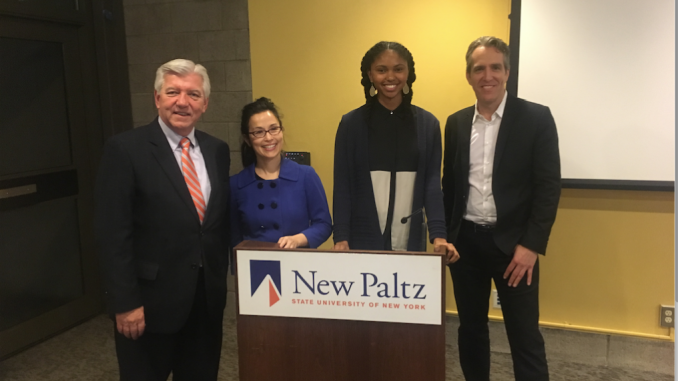
On Thursday March 8, New York State Assemblyman Kevin Cahill, D-Kingston visited SUNY New Paltz to discuss the positive impact that a carbon tax could have throughout the state if it were to be implemented.
Cahill, who is an alumnus of SUNY New Paltz, is currently sponsoring a bill in the state assembly (A.00107) that would initiate a statewide carbon tax. The bill is currently in the Ways and Means Committee, which Cahill described as a tax committee. There is also a version of the bill in the state senate (S.02846) sponsored by Sen. Kevin Parker, D-Brooklyn. As of January 2018, the bill is currently in the Investigations and Government Operations Committee.
Some details of the bill include that the Department of Environmental Conservation (DEC) would establish a tax on the distribution of carbon-based fuels that would be no less than $35 per ton of CO2. The price would increase by $15 per ton of CO2 annually. 60 percent of the profits made from the tax would go to residents in the state with very low to moderate incomes, while the remaining 40 percent would go towards making the state more energy efficient.
According to Cahill, the idea of a carbon tax in the state came from students at SUNY New Paltz.
“This shows the added value of college. Students bring new and better ideas into our society, which is exactly what the genesis of this piece of legislation was,” Cahill said.
“We can use less, that’s the best thing we can do. Using less electricity and fuel is a part of that paradigm shift that we have to accomplish.”
SUNY New Paltz economics professor Sara Hsu joined Cahill to touch on the economic benefits of the potential tax.
“Carbon emissions are a major source of climate change,” Hsu said. “They represent externalities that are not covered in the price of a good. The purpose of a carbon tax is to internalize this externality.”
Hsu also highlighted other potential benefits of the tax, including improving the environment and raising revenue that can be used on alternative energy sources, such as green electricity. She showed how climate change has affected New York and specifically the Hudson Valley area.
“There are climate models of New York that show that temperatures across the state will, on average, increase by 1.5-3.0 degrees fahrenheit by the 2020s, 3.0-5.5 degrees fahrenheit by the 2050s and 4.0-9.0 degrees fahrenheit by the 2080s,” Hsu said. “The sea level of the Hudson River is expected to rise at 1-5 inches by the 2020s, 5-12 inches by the 2050s and 8-23 inches by the 2080s.”
Cahill also discussed how he views this proposal as a positive resource.
“We can view the tax as a disincentive or view it as a resource. I tend to view it more as a resource,” Cahill said. “One of the goals of this bill is to conserve. Conserving is the best thing we can do.”
Cahill said that the carbon tax could be effective in changing the behaviors of people when it comes to energy usage.
“This legislation could change behavior, because we put an economic incentive in it. A pack of cigarettes that is $10 is package of tax, not a tax to stop you from smoking. It covers the damage done from smoking the pack of cigarettes,” Cahill said. “That’s what the carbon tax does. We have alternatives to using carbon we can use when we conserve, but there is a cost associated with it.”
While no state in the United States currently has a carbon tax, the presentation highlighted other countries, such as Canada and Sweden that do currently have a carbon tax. Sweden established their nationwide carbon tax in 1991, and their tax on C02 emissions currently sits at $150 per ton of C02. British Columbia, Canada established their tax in 2008. Before the presentation, Cahill discussed the effectiveness of the British Columbia carbon tax.
“Every place that a carbon tax has been initiated, it has been effective,” Cahill said. “Canada is planning to make the tax nationwide in the near future due to its effectiveness.”
During the discussion, Cahill touched on how a carbon tax in New York would raise $7 billion in its first year and $14 billion by its second year. He brought up how this funding could be beneficial to a place like New York City when it was hit by Superstorm Sandy in 2012.
“In 2012, Mayor Bloomberg looked for resources to storm harden New York City, but he he didn’t have the funds to do it. A carbon tax would create the funds to storm-harden our big cities across the state,” Cahill said. “We can keep having forums and informing our legislatures about the effects of climate change, or we can wait for the next big storm to hit again. I’m hopeful that the first approach will succeed.”
While Cahill acknowledged that there is still work to be done for the bill to pass, he is optimistic about the future of it.
“There are reasons to be optimistic, but there is still a lot more work to do,” Cahill said. “While I don’t think it will become a law this year, this carbon tax will happen, it’s an inevitability.”
